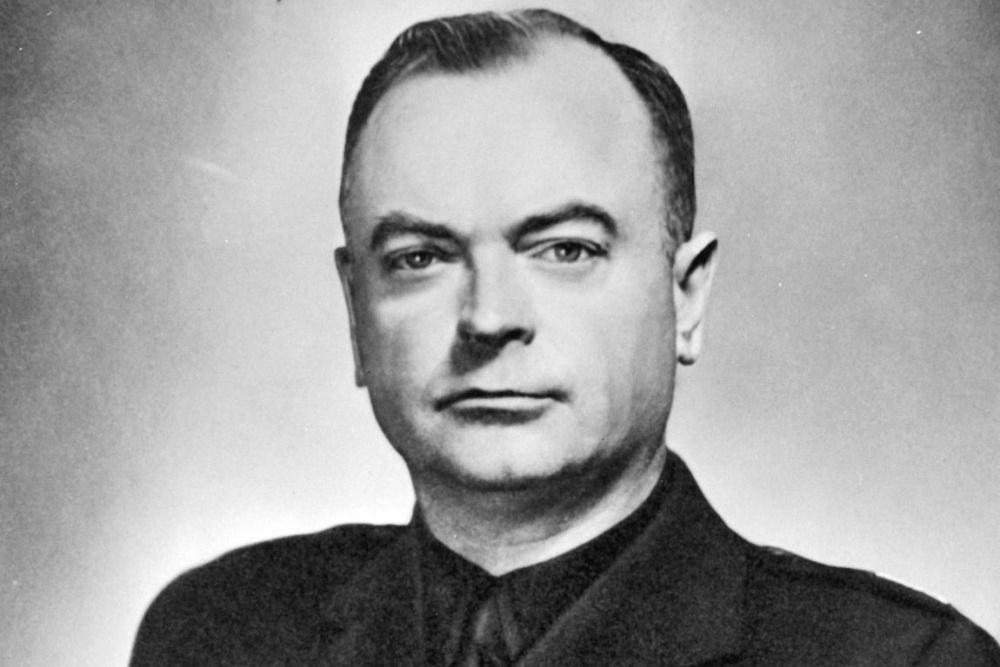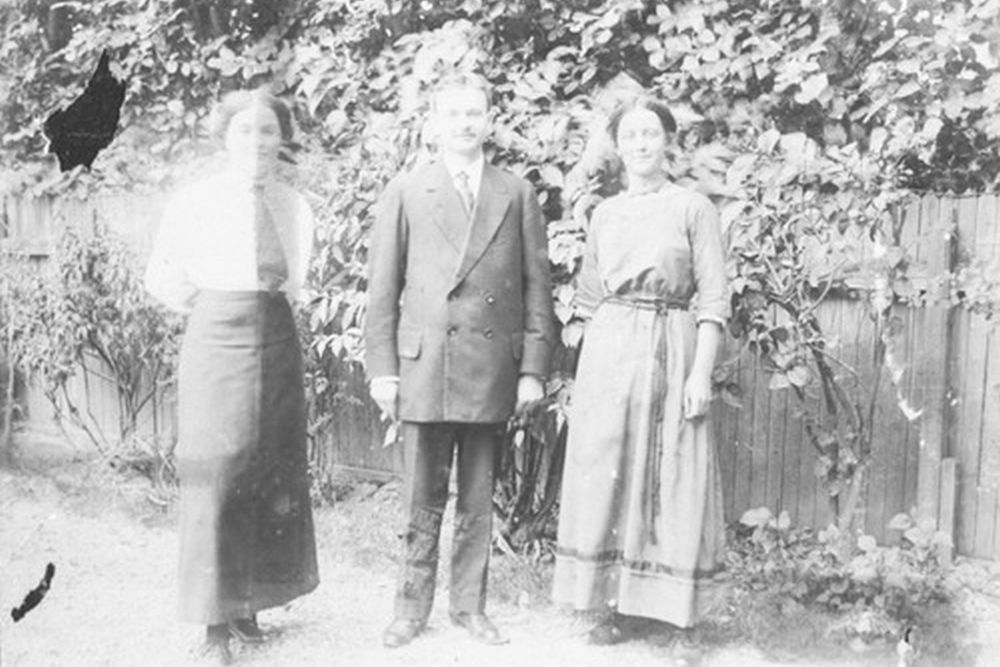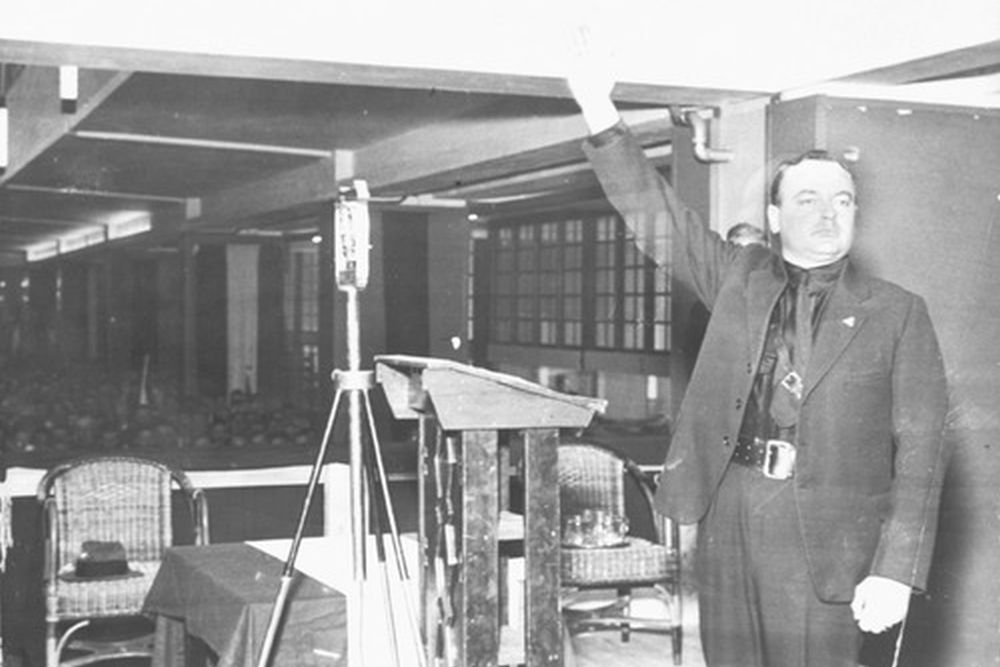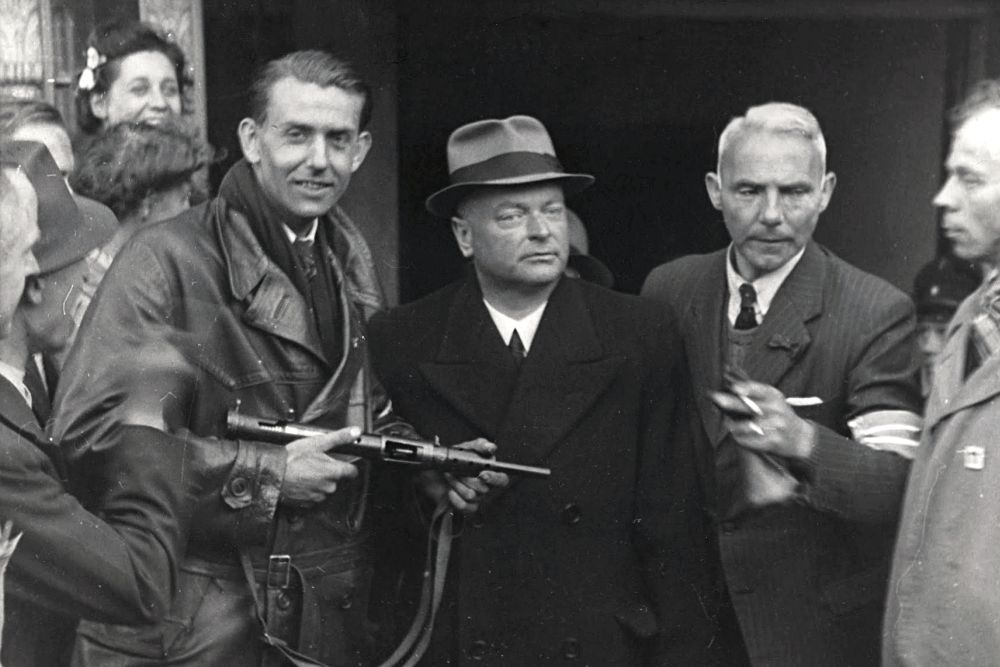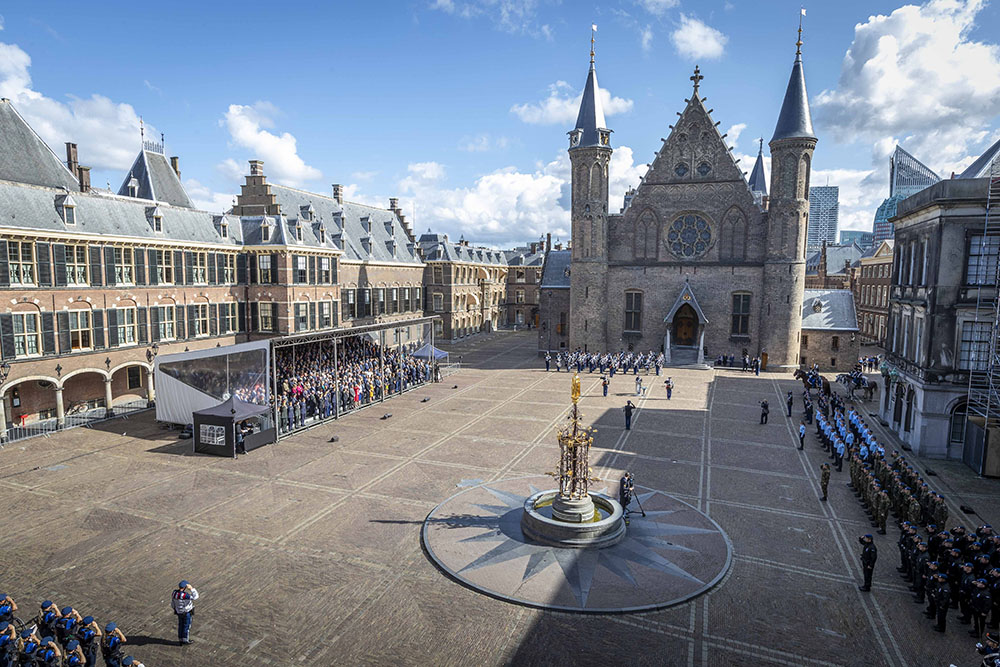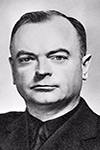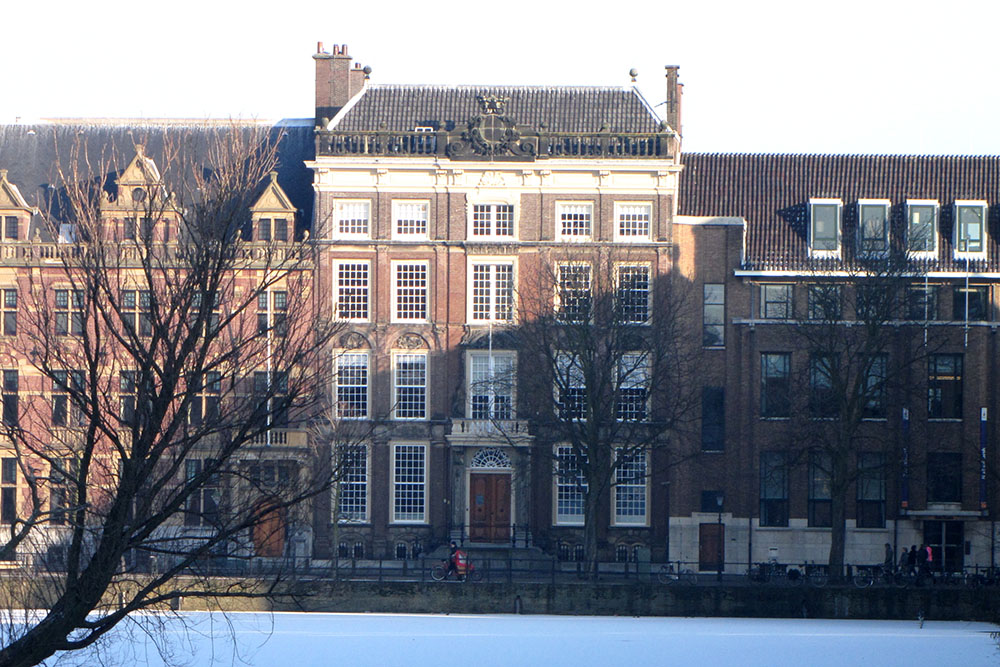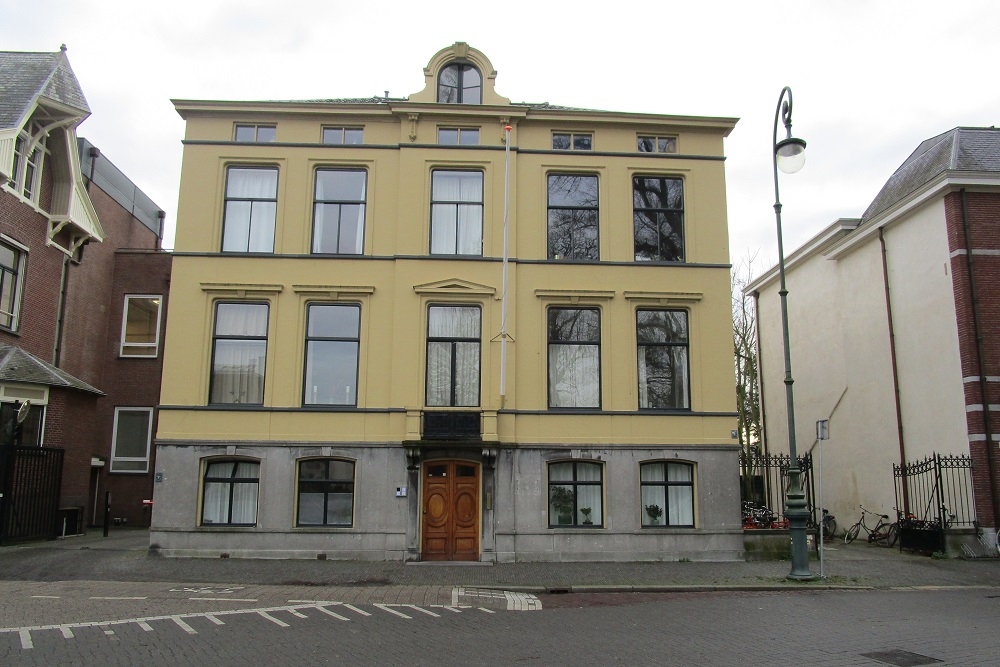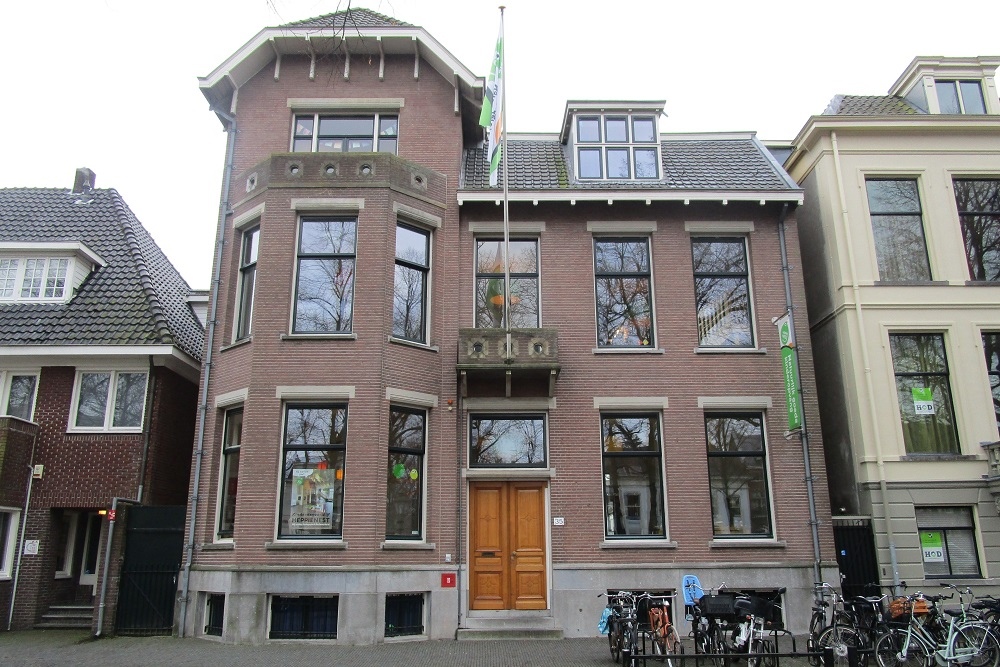Preface
Anton Mussert, born in 1894 became the leader of the Dutch National Socialist Movement (Nationaal Socialistische Beweging (NSB)). With his NSB he supported the politics of the Axis-powers. Beceause of his actions during the Second World War het was sentenced to death and executed in 1946.
Definitielijst
- NSB
- National Socialist Movement. Dutch political party sympathising with the Nazis.
The young Mussert
Anton Adriaan Mussert was born on 11th May 1894 in Werkendam of the marriage between headteacher Johannes Leonardus Mussert and his wife Frederika Witlam. Anton was the fourth child in the Mussert family. Eventually, five children would grow up in the Mussert household: sons Jo, Max and Anton and daughters Leni and Coby. Through his profession as a headteacher, Johannes Mussert and his family belonged to the elite of their village. Johannes Mussert was a man of distinction who had two sides to his personality. For the outside world he seemed to be an endearing man who was always there to help children who had trouble learning. Within his family he showed a completely different side and would not shy away from using corporal punishment to establish his authority. He did, however, pay sufficient attention to his family. His wife Frederika was rather a different sort of person. She was a snob who exploited her privileged position. These opposing personalities led the marriage into heated arguments which were fought in public and sometimes even in the classroom.
Their son Jo joined the army and quickly climbed to the rank of officer. The later activities of his brother, Anton, would prove problematic during the Battle of the Netherlands. When the young Anton started primary school, his brother’s position in society gave him prestige. Their older brother Max had followed in the footsteps of his father and had become a teacher. Their older sister Leni was studying to become a teacher.
At primary school, Anton was a loner. He was short in stature and became the victim of bullying by the local youth. He was an average pupil who was most interested in the history of the Netherlands, an interest that would remain with him until his death. After primary school, Mussert attended secondary school in Gorinchem. Here, he was also certainly not an outstanding student. His achievements were satisfactory but that was all. He remained the smallest in the class, a disadvantage that Anton compensated for with an athletic and well-built body. In 1912, he received his diploma. Inspired by his brother Jo, Anton wanted to become a naval officer but was rejected due to his height. His youth had made him ambitious, a trait that would be useful later in his career.
When his father Johannes was fired in 1912 after 33 years of trusted service, it caused big changes in the Mussert family. Following the advice of his father, Anton went to study at the Technical College in Delft. The family moved with him on 25th October 1912 to reduce his study costs. The house was located on the ground floor of 15 Kanaalweg. At the Technical College, Anton developed into a hardworking student with perfectionist tendencies. He was considered a serious student who did not become involved in the usual student parties. He remained just as reclusive as before. The only contact he had was with a fellow student, Willem Schermerhorn, who incidentally became the first prime minister after the war. The young Musset did not drink or smoke, he concentrated on his education.
On 8th January 1913, Anton’s father died suddenly. Anton was considerably affected by this and his education was to suffer. He was taken under the wing of Technical College assistant, Ploeg, and slowly climbed out of his melancholy. Mussert finished the year with excellent grades.
Mussert the military man
At the beginning of the First World War, Anton Mussert voluntarily signed up with the Dutch army. When he entered the barracks in Amsterdam, they did not know what to do with the short young man they were presented with. After being inspected, the 20-year-old Anton became a soldier within the artillery. After his very first exercise he was transferred to Schoonoord for corporal training. In the autumn of 1914 he earned his stripes. Shortly after, he was struck by kidney disease and released from service in 1915. After his illness, he went back to the Technical College in Delft to finish his education.
During his illness he was cared for by his aunt, Maria Witlam, who was 18 years older. The two fell in love. In spite of protests from the rest of the family and a fall out with his mother, they decided to marry. According to the law it was illegal for people as closely related as this to marry without an exemption from the Queen. They asked for an exemption and it was granted by Queen Wilhelmina. After receiving this approval, they married on 19th September 1917. They moved into a house in The Hague on the Rijswijkseweg.
During the course of his education, he befriended a Jewish student, Josephus Jitta who would later become a housemate of Mussert and his wife. The same Anton Mussert would later join the national socialists who sought to destroy the Jewish population. Anton Mussert graduated and received his diploma in civil engineering on 5th July 1918.
Definitielijst
- First World War
- Took place from 1914 till 1918 and is also named The Great War. The conflict started because of increased nationalism, militarism and neo-colonialism in Europe. Two alliances battled one another during the 4-year war, which after a dynamic start, resulted into static trench warfare. The belligerents were the Triple Alliance (consisting of Great-Britain, France, and Russia; later enlarged by Italy and the USA, amongst others) on the one hand and the Central Powers (consisting of Germany, Austria-Hungary, Bulgaria and the Ottoman empire) on the other hand. The war was characterized by the huge number of casualties and the use of many new weapons (flamethrowers, aircraft, poison gas, tanks). The war ended in 1918 when Germany and its allies surrendered unconditionally.
Engineer Mussert
After receiving his diploma with honours, he began working for the Rijkswaterstaat, responsible for the creation and maintenance of waterworks as an engineer in a temporary position. Sent to work on the construction of locks, he found himself working with the Jewish student, Josephus Jitta. In the summer of 1919 Anton Mussert was already a third ranking engineer and had achieved a permanent position. After 1st May 1920, Mussert started working for the Provinciale Waterstaat (an organisation for water management on a provincial level) in Utrecht. He became an excellent engineer and several of his plans were implemented.
Initially, Mussert was an unknown member of the Liberal Freedom League (or Liberale Vrijheidsbond). Only after 1925 did he enter the political foreground at a protest against a proposed treaty with Belgium concerning waterworks. On 3rd April 1925 the Dutch Minister of Foreign Affairs, Herman Adriaan van Karnebeek and his Belgian colleague, Paul Hymans, signed an agreement for a proposed treaty to improve the shipping connections between Antwerp and the Moerdijk. Another part of this treaty was the expansion of Belgian interests in the river Schelde. In the Netherlands there were protests against this. Mussert became the secretary for the National Committee of Action against the proposed treaty under the chairmanship of the director of the Dutch Bank, Johannes Luden. A provincial court clerk, Cees van Geelkerken was also in the committee. Mussert was spurred into action by the idea that the Dutch treaty was only accepted out of fear for the consequences of the Treaty of Versailles. Mussert thought that the treaty was most supportive of French interests and saw the plans as part of growing French imperialism. The National Committee of Action was so successful that the treaty was overruled by the Senate in February 1927 and the minister who was responsible for the treaty, Van Karnebeek, resigned. This successful result gave Mussert the conviction that he was a brilliant organiser. His contribution to this movement gave him valuable connections with people in positions of authority.
Via his membership of the National Union, Mussert evolved from being a liberal to a fascist. Cornelis van Geelkerken, in particular, had a large influence on the next steps of Mussert’s life. Mussert became a member of the Dietsche Bond, an organisation that hoped for the creation of a Greater Netherlands that would include Flemish Belgium. Part of his efforts for this cause was supporting Flemish activism in Belgium. He also joined the National Union of Sir Robert Frédéric Groeninx van Zoelen and Frederik Carel Gerretson. Over the years his interest in fascism increased.
On 1st November 1927, Anton Mussert was promoted to head engineer. At the age of 33 he was the youngest head engineer in the country. Under Mussert’s leadership the roadworks plan for Utrecht was improved, completed and executed. However, the bureaucratic hindrances that he bumped up against gave him an aversion to Dutch democracy. Convinced that automobile traffic was the future, Mussert was an advocate for the construction of highways. In 1931, he published his first work on this subject: ‘Ruim Baan voor de toekomst’ (‘Pave the way for the future’). His ideas for the development of a network of roads, situated on viaducts, would be discovered by a new audience in the 1970s. Mussert made valuable contributions in other areas, such as designing waterways. Mussert was able to influence national policy several times with his plans, without yet having any direct political influence.
Definitielijst
- democracy
- From the Greek: demos (the people) kratein (rules). Democracy is a form of government elected by the majority of the people in which the people can check on the leaders and have the government resign in case a majority of the people no longer agrees with the government.
- fascism
- Original name of the antidemocratic political movement in Italy under command of dictator “Il Duce” Benito Mussolini. Mussolini was the leader of Italy from 1922 to 1943. Nowadays the term fascism is a much used term for antidemocratic political movements. Sometimes German national socialism is called fascism.
- imperialism
- The policy of a state to extend its territory by annexations of border areas of other states through colonisation. After World War 2 the term got more of an economic and cultural meaning rather than the actual domination of a territory.
Mussert the politician
However, Mussert must have realised relatively quickly that he could have an influence on the political field. He was already toying with the idea of starting a political party in 1930. The foundation for this idea lay within his experience during the fight against the Belgian treaty. Mr. J. Zaaijer, a man he had worked with on this campaign, had recognised his political potential. (Later, the very same Mr. Zaaijer would demand the death penalty for Mussert and supervise his execution.)
However, these experiences were not the direct cause of his political activities. Everyone who was in contact with Mussert at the time recalled that he did not exploit these issues for political gain. Even his Jewish friend, Josephus Jitta, who had little reason to speak positively of him after the Holocaust, was convinced of this fact.
The reasons for Mussert’s political engagement can be found in the bureaucratic difficulties that he experienced with various authorities when trying to carry out his engineering plans. It took two years of thought and planning for Mussert to execute his plans for a political movement. In 1929 Mussert was concerned that the Netherlands was in great political and economic danger. He had no trust in the existing political parties’ ability to avert this disaster. He saw the threat of the "red plague" that was rising in Moscow. These uncertainties formed the basis for the political movement that he would establish and lead. He had no interest in setting up a political party. This would be a societal movement that would show the existing parties that things could no longer remain in the same.
On 14th December 1931, Mussert and Van Geelkerken set up the Nationaal-Socialistische Beweging (NSB, National Socialist Movement). How did this come about? Van Geelkerken had set up an organisation under the name of "De Bezem" (The Broom) together with Mrs. C. van der Voort van Zijp, after the fiasco of the Oranje-Nationalisten (Orange Nationalists). The movement failed to expand. Both were looking for a person who could function as a Dutch Mussolini, a man who could begin a mass movement. Both of them knew that Mussert was a good organiser and began to wonder if Anton Mussert was the man they were looking for. Mussert’s confidence in his ability to perform this task was growing.
Mussert became the political leader of the National Socialist Movement that was more based on Italian fascism than German Nazi fascism. Mussert admired Italian leader, Benito Mussolini. Although the NSB implemented a great deal of the German Nazi party’s agenda, the racist and anti-Semitic aspects were left aside. Anton Mussert, in choosing the name National Socialist and transferring aspects of the NSDAP to his party, had not been influenced by the content or background of national socialism in Germany. At this time he didn’t know exactly what national socialism was about. He had never read Hitler’s "Mein Kampf" (and he never would) and he did not share Hitler’s anti-Semitism at this point. Mussert wanted to avoid the term fascism since other fascist parties at the time had bad reputations. He had been inspired by the success of the NSDAP in the German elections. Of the twenty points in the NSB’s political manifesto, he had transferred sixteen from the NSDAP. Important sections such as eugenics and the Führer principle were not included. In Mussert’s opinion, these ideas did not suit the Dutch people. The four Dutch points of action were: connections with colonies overseas, a strong state authority (a fascist influence), the struggle for a Greater Netherlands including Flanders and, although not directly named, strong defence.
On Monday 14th December 1931, in a small hall in the building of a Christian Youth organisation in Utrecht, the movement was unveiled. Of the twelve people present, four people registered as the first members of the NSB, Mussert and Cornelis van Geelkerken aside.
Definitielijst
- fascism
- Original name of the antidemocratic political movement in Italy under command of dictator “Il Duce” Benito Mussolini. Mussolini was the leader of Italy from 1922 to 1943. Nowadays the term fascism is a much used term for antidemocratic political movements. Sometimes German national socialism is called fascism.
- Führer
- German word for leader. During his reign of power Adolf Hitler was Führer of Nazi Germany.
- Holocaust
- Term for the destruction of European Jewry by the Nazis. Holokauston is the Greek term for a completely burnt sacrifice.
- Mein Kampf
- “My Struggle”. Book written by Adolf Hitler, outlining the principles of National Socialism.
- national socialism
- A political ideology drawn up by Hitler based on the superiority of the German race, the leader principle and fierce nationalism that was fed by the hard Peace of Versailles. National socialism was anti-democratic and racist. The doctrine was elaborated in Mein Kampf and organised in the NSDAP. From 1933 to 1945 National socialism was the basis of totalitarian Germany.
- Nazi
- Abbreviation of a national socialist.
- NSB
- National Socialist Movement. Dutch political party sympathising with the Nazis.
- NSDAP
- Nazi Party, byname of National Socialist German Workers' Party, German Nationalsozialistische Deutsche Arbeiterpartei (NSDAP), political party of the mass movement known as National Socialism. Under the leadership of Adolf Hitler , the party came to power in Germany in 1933 and governed by totalitarian methods until 1945.
- socialism
- Political ideology aiming at slight or no class differences. Means of production are owned by the state. Evolved as a response to capitalism. Karl Marx tried to substantiate socialism scientific.
Political success with peaks and valleys
The construction of the NSB was tackled enthusiastically. Through investing in gatherings, Mussert, Van der Voort van Zijp and Van Geelkerken tried to spread the ideas of the movement. Their tactic was to encourage members of the gatherings to spread the word. However, this plan failed. The administrator who was selected by Mussert himself, threw the movement into chaos through financial and organisational failures. This fiasco revealed a weak point of Mussert’s, his poor judgement of people. This was a shortcoming that would later cause him trouble in his attitude towards Adolf Hitler.
Interviews with Mussert in the Nieuwe Rotterdamsche Courant and with Van Geelkerken in the Algemeen Handelsblad in 1932 resulted in an increase of interest in the movement. The number of gatherings also increased. During these gatherings, Mussert revealed himself to be a good speaker who knew how to communicate his message, though he lacked the flair of a talented orator. However, a disadvantage was that from the beginning, members who were against the NSB also joined in the debate. This often resulted in verbal conflict and on a few occasions, physical conflict.
As a consequence, in the autumn of 1932, the ‘Defence department’ (Weerafdeling, WA) was set up. Inspired by Mussolini’s blackshirts and Hitler’s SA, the WA was given a uniform and placed prominently at NSB gatherings. The WA was given a military structure with Mussert referred to as ‘Leader’, comparable to ‘Il Duce’ for Mussolini and ‘Der Führer’ for Hitler. In this period, Mussert required all members to refer to him as ‘Leader’. He institutionalised his position by including it in the charter for the establishment of the National Socialist Movement in The Netherlands in November 1932. Article 3 states that the government consisted of Mussert under the title of ‘General Leader’ with absolute power. Cornelis van Geelkerken was named the ‘General Secretary’ in the charter.
Initially the NSB grew strongly in a short period of time, from 1000 members in 1933 to 52,000 in 1936. The movement became militarised in this period. During a national gathering of members, known as a "Landdag", on 7 January 1933 in Utrecht, uniformed members of the WA made their first appearance. The NSB also released its party newsletter on this day, Volk en Vaderland (People and Fatherland). The first repressive measures against members of the NSB were taken by the Dutch government. On 30 January 1933, the Dutch government banned officers from joining the WA. In March followed a ban on military groups joining fascist organisations, such as the NSB. Moreover, NSB members were banned from joining the militia.
During the elections for the House of Representatives in 1933, Mussert decided, rightly so, that his movement was too small to aim to win seats in parliament. On 1st May 1933, the NSB moved into its first head office at 35, Oude Gracht in Utrecht. The growth of the movement meant that this location quickly became too small and in November 1933 the NSB moved again to another office at 354, Oude Gracht. The movement had around 20,000 members at this point. The growth was evident during the second Landdag on 7th October 1933. 6,000 people took part, 10 times as many as at the first Landdag in Utrecht.
In April 1935, the party took part in the provincial elections for the first time and received 7.94% of the votes. Mussert gained visibility through his trip to the Dutch East Indies. The growth of the fascist party had much to do with the personality of Mussert who, due to his reputation as a famous and reliable engineer, knew how to radiate a certain trustworthiness.
However, there were also setbacks. On May 1st 1934, Anton Mussert was fired from his job because being a member of a fascist party whilst working as a civil servant was now forbidden. A first consequence of this ban was a fall in membership by 5%, since many civil servants preferred to give up their membership than their jobs. On the other hand, the NSB was able to increase membership through the lack of ideology that Mussert displayed. This appealed to other right-wing movements that could thrive within the NSB. In spite of the damage to the outside reputation of the NSB, caused by people such as Meinout Rost van Tonningen and Johannes Hendrikus Feldmeijer, Mussert’s position inside the NSB camp was unaffected. On 3rd July 1934, Mussert visited the Italian fascist leader, Benito Mussolini. The meeting had a deep influence on Mussert.
The Landdag, which was organised on 20th March 1935, acted as a rehearsal for the elections. The gathering attracted 16,000 visitors. The election results for the Senate in April 1935 left the NSB with two seats. Through the growth, the existing office became too small again so the NSB moved into a new location at 35 Maliebaan in Utrecht.
After 1936 support for the NSB decreased suddenly. The cause was the position that the NSB took with regards to Benito Mussolini and Adolf Hitler. In October 1935 Mussert had openly chosen Mussolini’s side in the Italian invasion of Ethiopia. From this point onwards Mussert never publicly contested the military activities of Hitler or Mussolini. In March 1936, Mussert sided with Germany in the demilitarisation of the Rhineland. On 16th November 1936, Anton Mussert and Adolf Hitler met for the first time. The relationship between the NSB and Nazi Germany became stronger and the fascist heritage was exchanged for Nazi ideology. This was evident from a pamphlet written by Mussert, ‘The sources of Dutch national socialism’, that appeared in October 1937. In the pamphlet, Mussert embraced eugenics and attacked the Jewish people for the first time.
NSB publications became more and more anti-Semitic. In September 1938, Jewish people were banned from joining the NSB. Between January 1936 and May 1940, NSB membership fell from 52,000 to 30,000. Votes reduced from 4.22% in the House of Representatives election in May 1937 to 3.89% in the elections for the States-Provincial in April 1939. However, the NSB’s focus on Germany only grew. In 1938, Mussert described the annexation of Austria by the German Reich as the ‘liberation of the Austrians’ and he publicly chose the German side in the issue of Czechoslovakia. Even the invasion of Poland was supported and seen as Germany correcting the injustices of the Treaty of Versailles.
Definitielijst
- blackshirts
- Nickname for all followers of Mussolini dressed in black.
- Führer
- German word for leader. During his reign of power Adolf Hitler was Führer of Nazi Germany.
- ideology
- A collection of principles and ideas of a certain system.
- invasion
- Armed incursion.
- national socialism
- A political ideology drawn up by Hitler based on the superiority of the German race, the leader principle and fierce nationalism that was fed by the hard Peace of Versailles. National socialism was anti-democratic and racist. The doctrine was elaborated in Mein Kampf and organised in the NSDAP. From 1933 to 1945 National socialism was the basis of totalitarian Germany.
- Nazi
- Abbreviation of a national socialist.
- NSB
- National Socialist Movement. Dutch political party sympathising with the Nazis.
- Rhineland
- German-speaking demilitarized area on the right bank of the Rhine which was occupied by Adolf Hitler in 1936 after World War 1.
- socialism
- Political ideology aiming at slight or no class differences. Means of production are owned by the state. Evolved as a response to capitalism. Karl Marx tried to substantiate socialism scientific.
- Volk en Vaderland
- People and Fatherland. The daily newspaper of the NSB.
- WA
- Abbreviation of defence department, assault groups of the NSB
Mussert: Misunderstood leader with no real power
Despite his Nazi sympathies, Mussert was in favour of Dutch neutrality when the Second World War began in September 1939. He presumed that Germany would eventually need to invade the Netherlands but thought that this would result in a new, fascist Europe. The NSB would, naturally, take over leadership of the Netherlands. When Germany invaded the country on 10th May 1940, Mussert avoided actively helping the invaders and banned other NSB members from doing so. He was able to go underground so that he could avoid being detained by the Dutch government. On 10th May, with the first rumours of the German attack spreading, he had left the NSB headquarters to hide in an unknown location.
Before 10th May, from secret talks he had with representatives from the Abwehr Abteilung II (counter-intelligence), Mussert could already ascertain that the German invasion was in sight. A first meeting had already taken place in December 1939 with two Abwehr workers and Julius Herdtmann, the leader of the NSB sympathisers living in Germany. In early 1940, there followed a discussion with Abwehr officer, Neumeister. Both meetings were conducted in the presence of A.J.W. Harloff, responsible for matters concerning the Dutch Indies in the NSB. During the third meeting in April with Abwehr officer Scheuermann, they discussed the formation of a pro-German government after the German invasion. In the last discussion Mussert said he was prepared to form an NSB government. However, Mussert still hoped that a German invasion could be avoided, which was evident since he sent Rost van Tonningen and Juul op ten Noort to Berlin to make the case of Dutch neutrality to Himmler. It had no effect. Mussert must have considered this when he decided to go underground. When the German invasion became a reality, Mussert was transported in a hired car and went into hiding in Het Gooi.
After the Dutch surrendered, he travelled back to the NSB headquarters and went back home to be reunited with his wife who had just been released from prison. Then followed the tragic news that his brother Jo had died. Commander Jo Mussert had fought against the Germans as a camp commander in Dordrecht. On 14th May, he was arrested by two Dutch officers (reserve first lieutenant A.J. Kruithof and reserve captain A.J.C. Bom) who accused him of treason. During the arrest, he was shot and died a few hours later. It has never been confirmed that Jo Mussert really did commit treason, though after the Second World War his honour was posthumously restored, commissioned by General Henri Winkelman.
On Thursday 16th May, Mussert had already been visited by German officers. The first visit to Mussert was conducted by Scheuermann, a member of the Abwehr and his chief. The discussion that followed revealed the Germans’ true colours. Despite all the promises, it was obvious that Mussert would not be permitted to become the leader of the Dutch people. This was still his dream but it was shattered when it was announced on 19th May that the day before, Adolf Hitler had named an Austrian, Arthur Seyss-Inquart, as Reichscommisar for the occupied Netherlands. All further attempts Mussert made to grasp power came to nothing. This certainly had an influence on Mussert’s attitude towards the radicalisation required by the Germans. From the German viewpoint there would be no independent Netherlands within the German Empire.
Yet within the NSB, Mussert had supported radicalisation to a certain extent. He hoped that it would allow him to come into power with the NSB after the German invasion. After the invasion, the Germans showed little interest in the uncharismatic leader of the NSB. The radical and eloquent Rost van Tonningen had more influence on them. Despite his distrust of the Germans and the SS in particular, Mussert endeavoured to increase his influence. During a gathering of NSB members on 22nd June 1940, he spoke of his willingness to work with the Germans.
A change came in Mussert’s tactics after speaking with the German ambassador, Gottlobb Berger on 9th June 1940. He was told that the Netherlands would never gain independent status but would become a part of Germany. Also, he was told that Hitler had ordered the creation of an SS regiment, ‘Westland’ as part of the Waffen SS division ‘Wiking’ where, among others, Dutch people would be recruited. Initially, Mussert did not want to participate in either plan but by the end of the year he had changed his mind. A conversation with Hitler had been a tipping point. The meeting between the Dutch and German leaders would, Mussert hoped, clear the air. However, Hitler did not comment on the criticism from Mussert and on 11th September 1940, the creation of a Dutch SS became a reality. The unit even became part of the NSB and at the start of 1941, Mussert called upon his members to join the unit. With this move he hoped that so many Dutch people would join that the influence of the NSB would greatly increase. His plan failed, the troops came under the command of the Waffen SS.
In a last ditch attempt to gain influence over the Dutch SS, Mussert took a vow of loyalty to Hitler. He hoped that Dutch SS members would be able to avoid having to do the same since they had already vowed their trust via the NSB. This plan failed too. In May 1942, the Dutch SS members also had to take the vow. Time after time Mussert made the wrong move and his plans had the opposite effect. Neither Hitler nor the occupation authorities and the SS had any respect for Mussert. The only reason to collaborate was that Mussert seemed to be the only appropriate person to work with to influence the Dutch people and keep them under control.
One remarkable event involving Mussert cannot be left untold. In spite of the ever-growing antipathy towards the Jewish people, Mussert continued to feel a connection to the former Jewish members of the NSB who Mussert thought had always stayed faithful to the ideas of the NSB. A dozen of these people were given protection by Mussert as he brought them to Villa Bouchina, in Doetinchem. As well as this group of Jews, the Jewish artist Jo Spier and his family were transported there because they were acquaintances of Mussert’s sister-in-law. Eventually, Mussert could not hold back the deportation. He ensured, however, that they were not brought to a concentration camp but to the ghetto of Theresienstadt. Unfortunately, the conditions were not much better.
During the entirety of the war, Mussert made fierce attempts to win Hitler over. An early discussion occurred on 23rd September 1940 with Arthur Seyss-Inquart, General Commissioner Fritz Schmidt, Van Geelkerken (Mussert’s substitute) and, to the disappointment of Mussert and the insistence of Seyss-Inquart, Rost van Tonningen. Mussert was not a fan of Rost van Tonningen, therefore he had no official position within the NSB, despite being a Nazi sympathiser. In order to provide him a position in the discussion, he was named the substitute for Van Geelkerken. According to Mussert, Hitler had hinted in this meeting that Arthur Seyss-Inquart’s position was only in existence to prepare the country and people for Mussert’s leadership. However, according to a report from Schmidt, this depended solely on the extent that Mussert and the NSB were able to win over the Dutch people to the German cause.
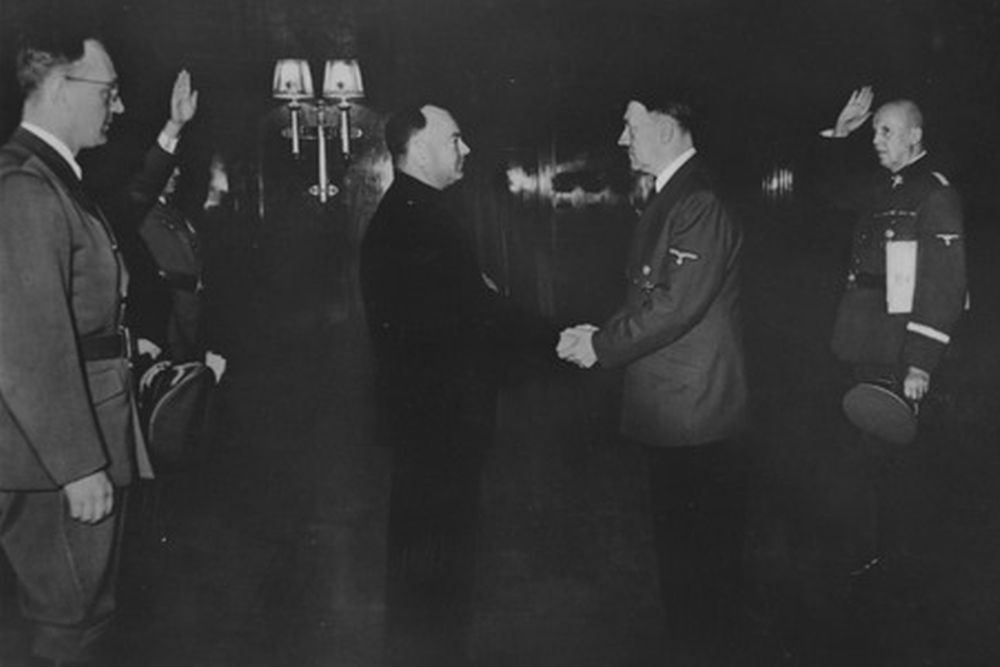
Mussert meets Hitler, december 1941 Source: Nationaal Oorlogs- en Verzetsmuseum Overloon / Liberty Park 145770
A second meeting with Hitler occurred on 12th December 1941. This time Mussert went especially to take a vow of loyalty to Hitler. As a consequence of the meeting, Mussert made plans to follow the footsteps of his Norwegian counterpart, Vidkun Quisling and be appointed Head of State. He backed this up by announcing that he could introduce conscription and thus create 30 new divisions for the Eastern Front. On 10th December 1942, he revealed his ideas to Hitler for the first time. Mussert went so far as to request that Hitler give him the possessions belonging to the Royal House that were taken by the Germans since he would be the new Dutch Head of State. This idea was not immediately rejected by Hitler but neither Hitler nor Seyss-Inquart considered Mussert capable enough to be the overall leader of the Netherlands. During the fourth visit to Hitler on 10th December 1943, Mussert wanted to further discuss this issue.
However, it became clear that the idea of an independent Dutch government would not come about while the war was still going on. Hitler did say, however, that the Dutch people should not be considered a conquered people. He also agreed to recognise Mussert as the leader of the Dutch people, without giving him any actual power along with the title. Having received recognition from Hitler, ‘The Secretary of State of the NSB’ was created with the aim of making preparations for a government with Mussert as a leader. In July 1944, the organisation moved into a monumental location at 3 Korte Vijverberg in The Hague. This was previously the domicile of the Queen's Cabinet and earlier, the home of Groen van Prinsterer. Mussert would never receive the Royal House’s possessions and he began to develop doubts over the Germans’ intentions. From 1944 onwards he was increasingly troubled by the fact that the Dutch population was having a harder time while the German occupiers were thriving. The course of the war also began to worry him. Yet he was convinced that this was not down to Hitler but mostly due to others such as Heinrich Himmler.
After September 1944, Mussert began to prepare for the evacuation of NSB women and children in the threatened south of the country. Hanns Rauter offered transport by train on the condition that Mussert would call on male NSB members to join the Landwacht (a paramilitary organisation). On the day of Dolle Dinsdag on 5th September 1944, panic broke out among NSB members. Many fled, but Mussert remained in Utrecht. The organisation, his NSB, collapsed and had practically ceased to exist. He no longer had control over his supporters. Everyone who could flee, did so with most of the exiled NSB members ending up in Lüneburg in Germany where an NSB settlement arose. Young NSB members, in particular, turned their backs on the movement and joined the German war machine. During the winter of 1944 to 1945, Mussert felt completely abandoned. There was no one that he could rely on within his own movement and the situation only became worse. On Saturday 7th April 1945 he gave his final political speech.
Definitielijst
- Abteilung
- Usually part of a Regiment and consisting of several companies. The smallest unit that could operate independently and maintain itself. In theory an Abteilung comprised 500-1,000 men.
- Abwehr
- Term used for the German military intelligence unit during the WW1 and WW2. From 1935 onwards under command of Admiral Wilhelm Canaris. The organisation often came into conflict with other secret services such as the SD and the Gestapo. During World War 2 under Canaris frequently a source for conspiracies against the Nazi regime until in 1943 a major conspiracy by a number of prominent members of the Abwehr was discovered and the Abwehr was placed under command of Himmler. After the assassination attempt on Hitler in 1944, Canaris was discharged and the Abwehr was dissolved. The conspirators and Canaris were prosecuted and in 1945 they were executed atc oncentration camp Flossenburg.
- concentration camp
- Closed camp where people are being held captive that are considered to be anti- social, enemies of the state, criminal or unwanted individuals. These groups mostly do not get a fair trial or are condemned to doing time in a camp.
- ghetto
- Part of a town separated from the outside world to segregate Jewish population. The establishment of ghettos was intended to exclude the Jews from daily life and from the rest of the people. From these ghettos it was also easier to deport the Jews to the concentration and extermination camps. Also known as “Judenviertel” or Jewish quarter.
- invasion
- Armed incursion.
- Jews
- Middle Eastern people with own religion that lived in Palestine. They distinguished themselves by their strong monotheism and the strict observance of the Law and tradition. During World War 2 the Jewish people were ruthlessly persecuted and annihilated by the German Nazis. . An estimated 6,000,000 Jews were exterminated.
- Landwacht
- Armed NSB-members with police authority.
- Nazi
- Abbreviation of a national socialist.
- neutrality
- Impartiality, absence of decided views, the state of not supporting or helping either side in a conflict.
- NSB
- National Socialist Movement. Dutch political party sympathising with the Nazis.
- regiment
- Part of a division. A division divided into a number of regiments. In the army traditionally the name of the major organised unit of one type of weapon.
- Theresienstadt
- City in the Czech Republic. Here the Nazis established a model concentration camp.
Demise
On 25th April 1945, Mussert was involved in a car accident when his car crashed with a Wehrmacht truck and was injured. He was taken to hospital ‘de Mariastichting’ in Haarlem. Through a surgeon who he befriended, his whereabouts were brought to the attention of a commander of a 'Knokploeg' (an armed resistance group) who was also a doctor. A plan was made to kidnap the NSB leader however NSB bodyguards arrived in the middle of the night and the plan was foiled. Mussert was released from hospital for a short period of time until he was once again taken to hospital, this time the Bronovo hospital in The Hague. On 1st May 1945 the message of Adolf Hitler’s death had arrived. In an announcement, Mussert honoured the German leader for one last time.
On 4th May, Mussert left the hospital and travelled to Utrecht. In the afternoon he arrived in The Hague at 3 Korte Vijverberg. In the evening he received the message of the German capitulation in the Netherlands. On Monday 7th May, Mussert informed the highest police authorities of his location in the Groen van Prinster House and surrendered himself to the new lawful authority. The first military vehicles appeared at 15:30 in the afternoon. At the backdoor, two people from the Binnenlandse Strijdkrachten and the observatory commission of the police who summoned Mussert outside. After some negotiation over the documents that Mussert wished to entrust to the Prime Minister, Mussert declared that he would be available from 7 o’clock. He wished to eat first. At the strike of 7, Mussert and his supporters, C.J Huygen and K.A. Enklaar were taken away. Mussert was taken to a prison in the Casuarisstraat. In July he was transferred to a prison in Scheveningen and put in cell 397. The summons followed in September 1945.
After his arrest on 7th May 1945, Mussert was charged with high treason. He was found guilty during a trial on 27th and 28th November. The accusations were: ‘attempting to bring the country under foreign rule’, ‘attempting to change the constitutional government’ and ‘assisting the enemy’. Mussert attempted one more time to defend himself but it was no use, the tide was against him. Arnold Meyer from the Zwarte Front, another movement that worked with the Germans, received a sentence of five years. The chief of the Nederlandsche Unie, Jan de Quay, who also had a questionable role during the occupation, was made a knight after the liberation, became the Queen’s Commissioner and even Prime Minister.
On Wednesday 12th December 1945 followed the sentence: the death penalty. Mussert listened calmly to the sentence. After his conviction he was taken first to cell 596 and later to cell 603. Mussert had one last move up his sleeve. He appealed against the sentencing on 20th February 1946. Once again the defence and Mussert made a plea but failed. The judgement was confirmed. Another request for pardon was filed but this was rejected on 5th May 1946. The execution was set for Tuesday 7th May. At 6:00, Mussert was collected by the commander of the prison. Shortly after, he left his cell for the last time. Mussert, Willem Terpstra (Mussert’s brother-in-law), reverend Sijbrandij and two guards entered the prison vehicle in the courtyard. At 6:27 Mussert got out of the vehicle at the Waalsdorpervlakte, walked over to the firing squad and at 6:30 he was dead.
Mussert’s body was buried anonymously at the General Cemetery in The Hague. If you think that Mussert’s story ends here then think again. On 17th June 1956, Mussert’s sister, Coby, was visited by the police and asked where Mussert’s body was. The night before, they had discovered that his body was missing. The newspaper, De Telegraaf, had received a phone call informing them that the remains had been dug up and taken away. The culprits had done their work carefully, so carefully that it was certain that they must have had access to the administration of the cemetery since the coffin with the number that corresponded to Mussert’s coffin was the only one missing. The coffins of Robert van Genechten and Max Blokzijl were still there. The government tried to maintain that the remains had not been removed but that the coffin had been shifted by the soil and could not be located. The remains were, in reality, probably dug up by four unknown NSB members and ex-Eastern Front soldiers, taken to Het Gooi, where many old NSB members still lived, and reburied in one of their gardens. Exactly where his remains are is unknown, however, there is much speculation. Some believe that his remains are still somewhere in Het Gooi and others think that one of the four ex-Eastern Front soldiers later took the coffin to Belgium.
Definitielijst
- capitulation
- Agreement between fighting parties concerning the surrender of a country or an army.
- Knokploeg
- Literally ‘assault team’ (abbreviated KP) and the term used by the Dutch resistance for the many locally organized armed fighting groups that undertook various resistance actions, ranging from sabotage and assassination to stealing food stamps and forging false ID documents.
- NSB
- National Socialist Movement. Dutch political party sympathising with the Nazis.
- resistance
- Resistance against the enemy. Often also with armed resources.
- Wehrmacht
- German armed military forces, divided in ground forces, air force and navy.
Information
- Article by:
- Wilco Vermeer
- Translated by:
- Rachael Darwin
- Published on:
- 19-01-2025
- Feedback?
- Send it!
Related sights
Related books
Sources
- KLEINGELD, H., De dood van Overste Mussert; een reconstructie, 2004.
- MEYERS J., Mussert Een politiek leven, Uitgeverij de Arbeiderspers, Amsterdam, 1984.
- Mussert, Neerlands Toekomst, NSB
- Nederlanders in de Waffen-SS
- Hoofdstukken uit de Nederlandse Geschiedenis
- Erepeleton Waalsdorp
- Erepeleton Waalsdorp
